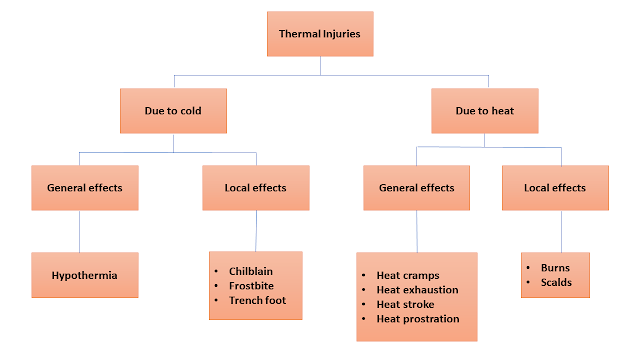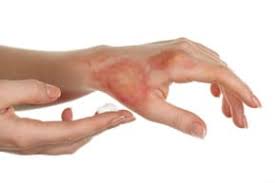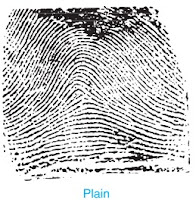Classification of Thermal Injuries
A) Cold Injuries
1. General Effects
1. Hypothermia
Exposure of the body to cold, below temperature 35 ℃ (95 ℉) is called Hypothermia. When the temperature of the body falls below 32 ℃ to 24 ℃, there is disorientation, loss of consciousness, loss of reflex, and a fall in respiration heart rate, and blood pressure. Red patches and pallor of the skin, edema of the face, and stiffness of neck muscle may be seen.
Postmortem Findings
1. External
Patches of pink/brownish-pink discoloration on the skin. Edema on feet and blistering of skin can be seen. The extremities may be white (White deaths)
2. Internal
Lungs are congested and show hemorrhages. The heart shows dilation of the right atrium and ventricle. Wischnewslay spots may be seen in the stomach. Fatty changes in the liver and contracted spleen. Hemorrhages in core muscle. Ulceration of the colon.
2. Local Effects
1. Chilblain
These are red, itching, and skin lesions due to exposure to cold. They may be associated with edema and blistering.
2. Frostbite
This thermal injury happens due to freezing and the formation of ice crystals on the skin which obstructs the supply of blood to tissues. It occurs due to exposure to great extremes of cold (-2.5 ℃) Blue-black discoloration of fingers, toes and other body parts like nose, ears, and face is seen. Edema, blisters, necrosis, and gangrene may also appear.
3. Trench foot
Trench foot also known as immersion foot is a type of immersion syndrome injury resulting from the exposure of body parts to severe cold (< 10 ℃). It is seen in soldiers who live in trenches.
B) Heat Injuries
1. General Effects
1. Heat cramps
This thermal injury developed in workers who work in high temperatures when the sweating has been profuse. This causes rapid fluid and electrolyte depletion in the body. The person may report a flushed face, dilated pupils, dizziness, headache, etc.
2. Heat exhaustion
This thermal injury is developed due to inadequate water or salt intake in the body during a hot environment. This is followed by dehydration and fluid loss in the body. The person may report nausea, vomiting, and even heat stroke.
3. Heat stroke
Heat stroke is a life-threatening medical emergency resulting from the failure of the thermoregulatory mechanism. The victim shows cerebral dysfunction, impaired consciousness, high fever (> 41 ℃), and absence of sweating.
Postmortem Findings
Lungs are congested. The heart shows subendocardial hemorrhages. The brain is congested and edematous
4. Heat prostration
This thermal injury is developed due to salt depletion and dehydration due to excessive sweating. This condition is usually seen in the tropics and deserts.
2. Local effects
1. Burns
Burn is a thermal injury caused by heat or by a chemical or physical agent having an effect similar to heat.
Following are some common types of burns:
1. Contact Burns
These are developed due to physical contact between the body and a hot object like solid or molten metal.
2. Flame Burns
These are developed due to contact of the body with flame.
3. Scalds
They are caused by contact with hot liquids, most commonly water, and usually occur on exposed skin.
4. Chemical burns
They are caused by the application of acids, alkalis, etc.
5. Radiant heat burns
They are caused by heat waves which are a type of electromagnetic wave. There is no physical contact between the body and flame or hot surface.
Classification of burns
1. Wilson Classification
According to this, various burns injuries can be categorized into 3 types depending body layer involved.
1. Epidermal
These occur in reddening and blister formation. These are painful and heal without the formation of any scars.
2. Dermo-epidermal
These occur when the full thickness of the skin is involved in burns like hair follicles, sweat, and sebaceous glands. These are extremely painful and heal with the formation of scars.
3. Deep
These occur when deeper tissues below the skin that is subcutaneous tissues, muscles, and bones are involved. They are relatively less painful and heal with the formation of scars.
2. Dupytren's classification
According to the depth of tissue involved, he classified burn injuries into six categories:
1. First Degree
These occur when a low degree of heat is applied for a very short duration of time. It remains painful for a day or two and redness fades in a few hours or a day.
2. Second Degree
This occurs when the epidermis is affected completely due to the application of heat. Blisters formation takes place which is very painful. They usually heal within 7 days without scar formation.
3. Third degree
This occurs when the epidermis is completely destroyed with the involvement of the dermis. Blisters formation takes place with a red line. They heal with the formation of scars.
4. Fourth Degree
This occurs when the whole thickness of the skin is involved. These are not much painful owing to the destruction of nerve endings.
5. Fifth Degree
These occur when the depth of the lesion extends further and subcutaneous tissue is involved. These are less painful due to the total destruction of sensory nerve endings. They heal with deep scarring.
6. Sixth Degree
These occur with muscle and bone are involved. These occur charring of the limb and heal with much difficulty with contracture formation.
Postmortem Findings
1. External Findings
- Clothing should be carefully removed and examined for the presence of kerosene, petrol, or any other inflammable substance.
- Site, distribution, and extent of burning are recorded.
- The face is usually distorted and swollen and the tip of the tongue is usually burnt.
- Blisters either ruptured or filled with fluid may be seen.
- Postmortem staining is cherry red in color due to the presence of carbon monoxide (CO), if the individual was alive and breathing during the fire.
- Antemortem burn shows redness.
- Hair may be singed, or partially/ completely burnt.
2. Internal Findings
- Charring of the skull is seen due to intense heat.
- The brain appears congested and swollen. Subdural hemorrhage may be present.
- Hemorrhage in the root of the tongue and neck muscles.
- The larynx, trachea, and bronchioles contain carbon and soot particles.
- Heart chamber full of blood, cherry red in color due to inhalation of carbon monoxide.
- The stomach and intestines may contain carbon particles.
- The spleen is enlarged and softened.
- Fatty liver and cloudy swelling in the liver.
- Adrenals may be enlarged and congested.
2. Scalds
A scald is a thermal injury that results from the application of liquid at a temperature greater than 60 ℃ or steam. It damages the superficial layers of the skin. Following are the types of scalds.
1. Immersion burns
Accidental or deliberate immersion in hot liquid, usually water.
2. Splash or spill burns
Usually accidental.
3. Steam burns
They occur due to the application of superheated steam.




